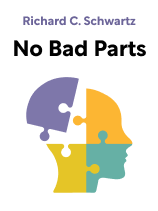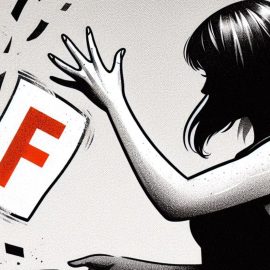

This article is an excerpt from the Shortform book guide to "No Bad Parts" by Richard C. Schwartz. Shortform has the world's best summaries and analyses of books you should be reading.
Like this article? Sign up for a free trial here.
What is Internal Family Systems? What are the different parts of the IFS model of psychotherapy?
Internal Family Systems (IFS) is a model of psychotherapy developed by psychiatrist Richard Schwartz. In a nutshell, IFS is a form of talk therapy aimed at helping people heal wounded parts of their psyche and end negative patterns within the internal family system.
Keep reading for an overview of the Internal Family Systems model, key terms, and a look into what IFS therapy looks like in practice.
IFS Therapy in Practice
The goal of the Internal Family Systems model of psychotherapy is to heal our inner family system by healing the wounded parts of ourselves so that we can approach ourselves and the world with more compassion and curiosity. IFS-trained therapists use questions, suggestions, and active listening to guide clients through the process of getting to know their inner family system and healing their wounded parts.
IFS is premised on the idea that instead of being only one person, we all hold multiple people within us—a core Self and multiple co-existing internal parts (or subpersonalities) that relate to each other in the same ways that members of a family might relate to one another. Just like a family, our internal system can be supportive and loving, or toxic and destructive.
Before trying to change anything about our internal family system, Dr. Schwartz recommends starting to develop awareness about our inner system, starting with the Self.
The Self
The Self is the leader of the internal family system—innately wise, compassionate, and patient. According to Schwartz, the Self doesn’t overpower or undermine our parts, but rather acts as a “caretaker” for them. Schwartz describes the Self as a healthy, loving parent-figure whose purpose is to guide and nurture the parts. Unlike the rest of the parts in our internal system, we can’t observe or speak to our Self because it is the “seat of consciousness” from which we experience our internal and external worlds.
| Other Ways to Conceptualize the Self IFS therapist Allesio Rizzo offers three alternative descriptions of the self that may resonate with different people depending on their belief systems: 1) The traditional IFS approach describes the Self as the “absence of parts,” or what’s left when all the parts have stepped back, allowing Self to shine through. 2) The Self can also be understood as a kind of inner “Higher Power” similar to God in many religious traditions. 3) Finally, the Self can be described as the “undamaged” part of yourself—a piece of who you are that can’t be harmed or compromised and is capable of healing the parts of you that have been harmed. |
When we notice ourselves feeling openhearted and curious, we’re practicing what Schwartz refers to as Self-leadership or Self energy. Consider the following example. It’s Sunday night. You’re tired and thinking about taking the morning off from work. One part of you tells you that you need to rest, while another part scolds you for slacking. You might feel guilty about wanting a morning off or worried about what your boss will say if you stay home. These feelings stem from parts. However, if you’re practicing Self-leadership, your Self would be curious about these seemingly conflicting desires and want to know more about the motivations behind them.
(Shortform note: Self-leadership occurs when we embody the inherently good qualities of the Self—compassion, curiosity, patience, and kindness. While people have long debated what lies at the core of human nature, Schwartz is not alone in thinking that human nature is innately good. In Humankind, Rutger Bregman explains how humans have evolved to be kind and multiple studies have shown that people consistently choose cooperation over selfishness, even showing a preference for helpfulness as infants.)
The Parts
The next step in getting to know your inner family system is getting to know your parts.
Each of our parts, or subpersonalities, is a piece of who we are. They have their own goals and motivations, even memories, and different levels of wisdom, maturity, and emotionality. They might take on different forms or be a younger version of ourselves.
All of our parts have good intentions for us, but parts can sometimes get trapped in roles that make them act in extreme, unproductive, or destructive ways. For example, someone who has experienced abuse as a child might have a part that’s trapped in that traumatized place, and a part who, out of a protective instinct, routinely sabotages intimate relationships for fear of getting hurt.
Like getting to know our Self, the first step in getting to know our parts is practicing greater self-awareness. When do certain emotions come up and why? For example, imagine you have dinner plans with a friend and they show up 40 minutes late. If part of you feels deeply angry at your friend, that angry part might be a defense mechanism to protect you from the deeper fear of being abandoned. Paying closer attention to your emotional landscape will help you get to know the parts in your inner family system.
While Schwartz emphasizes that all internal family systems are unique to the individual, our parts tend to organize themselves into one of two categories: vulnerable parts (called exiles) and protective parts.
Exiles
Schwartz refers to our vulnerable parts as exiles. Exiles are the youngest and most vulnerable versions of who we are, sometimes referred to as our “inner children.” They’re often the parts that have directly experienced some kind of trauma and then took on the burden of those emotions, leaving them trapped in the past.
While these inner children are often sweet, innocent, playful, and trusting, they’re also highly sensitive and prone to being hurt. Exiles are the parts of ourselves that we’re most likely to hide because we don’t want to experience their hurt or shame. For example, imagine you were yelled at for crying when you were a young child. This might create an exiled part of you that feels shame anytime you cry in front of other people.
Protectors
Meanwhile, our protective parts are the parts of ourselves that take on the role of defending our exiles from future hurt. To continue the above example—if there was an exile that felt shame for crying publicly, there might be a protector who shows up when the exile is feeling especially sad who tells the exile to “suck it up.” Schwartz emphasizes that where there are exiles, there are always protectors.
Schwartz distinguishes between two types of protectors. Managers are protective parts that act preemptively to keep us safe by attempting to control our environment—carefully managing who we date, what we wear, and how we’re perceived to ensure that nothing can happen to trigger the same feelings experienced by our exiles. Managers are often our most critical inner voices. Their burden is containing and protecting the most vulnerable parts of who we are.
Firefighters are protective parts that act reactively when they think we’re in danger—usually when there’s an overwhelming flood of emotions. Firefighters want to remove us from what we’re feeling. They might make us throw ourselves into work, binge-watch a show, use substances to numb pain, or, in extreme cases, commit suicide, in an attempt to remove us from what we’re feeling. Their burden is suppressing powerful emotions when they do flare up.
Healing Your Inner Family System
After developing a better understanding of our internal system, the next step is to heal our inner family system by healing our wounded parts, allowing them to step out of the roles they’ve been forced into. In this section, we’ll discuss two key steps in healing our inner family system: unblending and unburdening.
Unblending
Before we can help our parts, we must be able to unblend from them. In our day-to-day lives, the Self is frequently overpowered by one or more of our parts—a phenomenon Schwartz calls “blending.” When a part and our Self are “blended,” the feelings and perspective of a burdened part merge with the Self. The compassion and patience of the Self becomes eclipsed by the needs, desires, and intentions of the part.
Blending is most common in moments of intense emotion. For example, if a parent criticizes a recent career choice, an exiled part searching for parental approval might feel deeply hurt, causing a protective part to step in as defense. When the protector blends with the Self, they may yell, criticize, or stonewall as a tool or protection.
We can practice unblending by noticing when we’re embodying qualities of the Self and what it feels like to embody the Self. According to Schwartz, every person’s Self shares the same set of qualities, such as open heartedness and curiosity. Schwartz explains that when we’re Self-led, we often experience a feeling of spaciousness, and perhaps, most noticeably, an absence of internal voices of anxiety, self-doubt, and fear. Though nobody can be Self-led all the time, noticing when we’re embodying the Self and what it feels like to be Self-led will allow us to unblend more easily when we need access to the Self.
Unburdening
When we’re no longer blended with our parts, we can start the process of helping our parts unburden, or letting go of the emotional weight that keeps them trapped in their role. Unburdening our exiles is key to healing the whole inner family system.
Parts won’t fully unburden unless they trust the Self to lead. However, once the Self is able to help the parts feel safe enough to unburden the emotions they’ve been carrying, they’re able to let go of the roles they’ve been forced into and take on healthier roles within the internal family system. For example, a part who has taken on the role of protector who no longer needs to protect an exile might instead put its energy towards forging new social connections or exploring creative outlets.
(Shortform note: IFS therapists emphasize that unburdening must be a spontaneous process. We can’t force parts to unburden themselves, and following all the right steps doesn’t mean a part will automatically unburden. Parts will only unburden when they’re ready.)
Before we can unburden our parts, we must be able to access and communicate with them. Our exiles, the most wounded parts of ourselves, are often the hardest to reach—buried deep and guarded by protective parts working to prevent our exiles from emerging and getting hurt again. So, in order to access our exiles, we must first work with our protectors.
(Shortform note: There are three main reasons why some parts of ourselves become exiles. First, a caretaker or peer responded negatively when we showed vulnerability. This can be especially true for young boys. Second, a caretaker or peer responded negatively when we were too exuberant or active. This can be especially true for young girls. And third, our emotional response to being hurt was criticized or shamed by others.)
Protectors must give us permission to access our exiles. The most important thing to communicate to protectors is that the Self is capable of keeping the internal family system safe. Then, when the protector trusts the Self enough, they will step back in order to allow the Self to speak with an Exile. This process can take a long time. For example, if a part is not willing to allow the Self to access an exile or even talk, an IFS therapist might encourage the Self just to imagine sitting next to the protective part, allowing the Self to build trust through proximity.
| The 6 Fs: A Strategy for Working with Protectors While not described in No Bad Parts, IFS outlines a process known as the 6 Fs, which offers a road map for working with protectors. 1. Find: Instead of trying to find a specific part directly, identify a challenging situation or behavior in your life. Talking about a challenge can sometimes help you find the part associated with that challenge. 2. Focus: After finding the part that’s impacted, focus inward on the emotions and physical sensations associated with the part. 3. Flesh out: Flesh out the part by listening to its story and learning more about its feelings and needs. 4. Feel: Ask yourself how you feel toward the part. If you feel nothing, that part is still blended with the Self. If you feel annoyed or frustrated, the Self is likely blended with another part because the Self only feels compassion for its parts. However, if you feel open and curious toward the part, then you’re operating from a state of Self-leadership. 5. Befriend: When both the Self and the part are present, the Self can befriend the part and begin to form an authentic and loving relationship based on mutual respect and compassion rather than fear or control. 6. Fears: Discover the deepest fears of the part. Deeply held fears often keep parts trapped in unproductive roles. Understanding the fear is the first step in letting the fear go. |
When our protectors allow us to access our exiles, we can begin to develop trust with the exiles. The most important thing to communicate to exiles is that you have compassion for their pain and trauma. Then, invite them out of the sad place where they are. When inviting exiles out of the past, you can ask them to imagine a place or time that feels safe for them. You can then invite them to let go of the emotion they’ve been holding, even visualizing washing it away or releasing it into the air.
(Shortform note: According to IFS therapists, it is not enough to listen to an exile’s story. In order to heal an exile, we must fully integrate the exile’s experience into our identity, so that instead of being embarrassed or ashamed by the feelings or experiences of our exile, we appreciate them and understand them as a critical piece of who we are.)

———End of Preview———
Like what you just read? Read the rest of the world's best book summary and analysis of Richard C. Schwartz's "No Bad Parts" at Shortform.
Here's what you'll find in our full No Bad Parts summary:
- A detailed look at IFS—a psychotherapy model that challenges the idea of a unitary mind
- Why it's normal to have conflicting voices in your head
- What IFS therapy looks like in practice and its benefits






